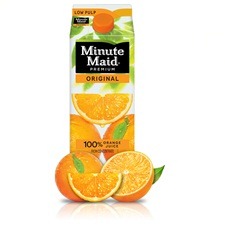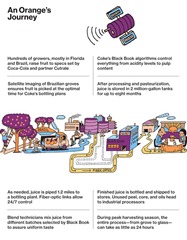 Don’t let the name fool you. Coca-Cola’s Simply Orange juice is anything but pick, squeeze, and pour. That cold glass of 100 percent liquid sunshine on the breakfast table is the product of a sophisticated industrial juice complex. Satellite imagery, complicated data algorithms, even a juice pipeline are all part of the recipe. “You take Mother Nature and standardize it,” says Jim Horrisberger, director of procurement at Coke’s huge Auburndale (Fla.) juice packaging plant. “Mother Nature doesn’t like to be standardized.”
Don’t let the name fool you. Coca-Cola’s Simply Orange juice is anything but pick, squeeze, and pour. That cold glass of 100 percent liquid sunshine on the breakfast table is the product of a sophisticated industrial juice complex. Satellite imagery, complicated data algorithms, even a juice pipeline are all part of the recipe. “You take Mother Nature and standardize it,” says Jim Horrisberger, director of procurement at Coke’s huge Auburndale (Fla.) juice packaging plant. “Mother Nature doesn’t like to be standardized.”
Coca-Cola, maker of the Minute Maid and Simply Orange brands, is using its balance sheet and distribution reach to methodically build a global juice machine. That includes the U.S., Coke’s largest market, accounting for one-third of its volume sold. PepsiCo (PEP), led by its Tropicana brand, commands a 40 percent volume share of the $4.6 billion U.S. market for not-from-concentrate juices, compared with 28 percent for Coke, according to Euromonitor. Globally, the market researcher says, Coke gets about $13 billion in revenue annually from pure juice and juice drinks. “You see them focusing on still beverages because that’s been outgrowing sparkling drinks for several years now,” says Thomas Mullarkey, an analyst for Morningstar (MORN) in Chicago.
At the core of Coke’s plan in the U.S. is 100 percent not-from-concentrate OJ, for which consumers are willing to pay as much as a 25 percent premium. Yet producing the beverage is far more complicated than bottling soft drinks. Juice production is full of variables, from weather to regional consumer preference, and Coke is trying to manage each from grove to glass.
In bucolic Auburndale, an hour south of Disney World, Coke has spent $114 million in recent years expanding its premier U.S. juice bottling plant, which it claims is the world’s largest. It’s here that Coke has perfected a top-secret methodology it calls Black Book to make sure consumers have consistent orange juice 12 months a year, even though the peak growing season lasts about three months. “We basically built a flight simulator for our juice business,” says Doug Bippert, Coke’s vice president of business acceleration.
Black Book isn’t really a secret formula. It’s an algorithm. Revenue Analytics consultant Bob Cross, architect of Coke’s juice model, also built the model Delta Air Lines (DAL) uses to maximize its revenue per mile flown. Orange juice, says Cross, “is definitely one of the most complex applications of business analytics. It requires analyzing up to 1 quintillion decision variables to consistently deliver the optimal blend, despite the whims of Mother Nature.”
The Black Book model includes detailed data about the myriad flavors—more than 600 in all—that make up an orange, and consumer preferences. Those data are matched to a profile detailing acidity, sweetness, and other attributes of each batch of raw juice. The algorithm then tells Coke how to blend batches to replicate a certain taste and consistency, right down to pulp content. Another part of Black Book incorporates external factors such as weather patterns, expected crop yields, and cost pressures. This helps Coke plan so that supplies will be on hand as far ahead as 15 months. “If we have a hurricane or a freeze,” Bippert says, “we can quickly replan the business in 5 or 10 minutes just because we’ve mathematically modeled it.”
by Duane Stanford from Business Week


